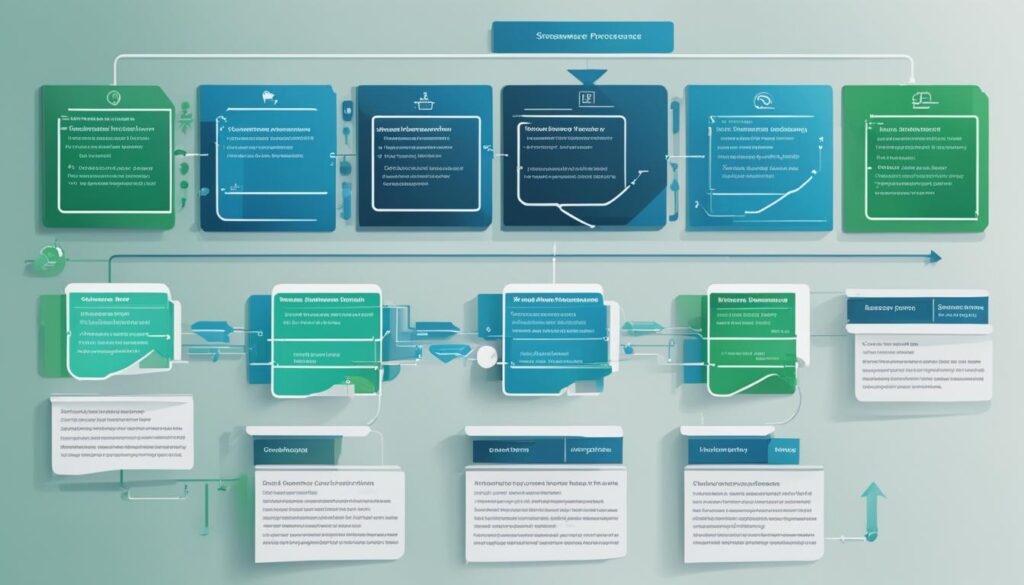Today’s competitive business environment requires efficiency and effectiveness, with process optimization becoming crucial for improved productivity and reduced costs. Operating procedure software, also known as SOP software or standard operating procedure software, serves as a vital tool in this quest, offering systematic design, modeling, execution, monitoring, and continuous improvement of standard operating procedures. The use of workflow management software streamlines tasks, minimizes manual intervention, and enhances customer satisfaction, leading to a strategic competitive edge for modern organizations.
Embracing software solutions for managing standard operating procedures is a key strategic move in embarking on a more agile and efficient operational journey, resulting in consistent and reliable outcomes that contribute to overall business success.
Key Takeaways
- Operating procedure software is a vital tool for process optimization in a competitive business environment.
- SOP and standard operating procedure software enable the design, execution, and monitoring of streamlined procedures.
- Workflow management software minimizes manual intervention and enhances operational efficiency.
- Adopting SOP tools is a strategic move for achieving consistent and reliable business outcomes.
- Increased efficiency with SOP software results in customer satisfaction and a competitive edge.
The Importance of Streamlining Business Operations
Streamlining business operations is integral to achieving an organization’s goals. Business Process Management (BPM) is a cornerstone of this effort, providing a holistic approach that significantly enhances efficiency and performance. With the implementation of business process management software and process documentation software, organizations can optimize their workflows, resulting in a variety of tangible benefits.
- Efficiency in operations
- Enhancing productivity
- Cost reduction
- Improved customer service
By automating routine tasks, reducing errors, and smartly managing resources, businesses can execute projects effectively and enjoy a robust competitive advantage. As a result, organizations are better equipped to adapt to the ever-changing business landscape and maintain a consistent trajectory of growth and success.
Defining SOPs within Operating Procedure Software
Standard Operating Procedures (SOPs) serve as the backbone of operating procedure software, ensuring standardization and consistency in business processes. Incorporating an effective SOP tool within your organization results in more efficient operations and smoother workflows. SOP management software streamlines the entire lifecycle of SOPs, from creation and documentation to implementation and updates. Let’s delve deeper into the role of SOPs in enhancing business efficiency and their lifecycle within operating procedure software.
What SOPs Entail and Their Role in Business Efficiency
Standard operating procedure documentation provides a set of detailed, step-by-step instructions that outline the best way to perform routine tasks and processes. Utilizing SOPs in your business has several advantages:
- Streamlined operations through standardized procedures
- Improved productivity and efficiency as employees follow best practices
- Reduced errors and increased compliance with industry regulations
- Better training for staff, ensuring consistent task execution
- Continuous improvement in business processes
By leveraging efficient SOP management software, organizations can create, manage, and maintain SOPs in a centralized location, providing employees with standardized methods for performing tasks and promoting consistency across the organization.
The Lifecycle of SOPs from Creation to Execution
The SOP lifecycle within operating procedure software comprises several stages:
- Creation: Develop detailed SOPs by researching industry best practices and identifying the most efficient methods for completing tasks.
- Documentation: Record the procedures in a clear, concise manner, with step-by-step instructions to ensure understanding and consistency among team members.
- Approval: Subject matter experts review and approve the SOPs to ensure compliance with industry standards and regulations.
- Implementation: Integrate the SOPs into daily operations, providing staff with access to the standardized procedures for performing their tasks.
- Training: Equip team members with the skills and knowledge to adhere to SOPs, fostering a culture of consistency and efficiency.
- Review and update: Regularly revisit and evaluate SOPs to ensure they remain relevant and aligned with current best practices, making updates as needed.
By effectively managing SOPs throughout their lifecycle, organizations can harness the power of standard operating procedure documentation in driving efficient operations and achieving business success.
Key Features of Top SOP Management Software
Leading SOP management software is characterized by several essential features that contribute to an efficient and optimized workflow. To begin with, the software’s intuitive interfaces and user-friendly functionalities enable employees to easily access and follow procedures. Moreover, centralized document repositories ensure that up-to-date information is always readily available.
Another notable benefit of top-tier procedure management software is the integration of automation features. These facilitate collaboration and knowledge sharing across teams and departments, resulting in seamless communication and streamlined operations. Furthermore, integration with training programs allows for effective task execution, guaranteeing consistent performance across an organization.
In addition to these features, top SOP management software provides real-time updates and communication, allowing users to stay informed and react quickly to any procedural changes. This empowers businesses to maintain their competitive edge by continuously enhancing and refining their operating procedures.
Scalability is another crucial aspect of potent procedure management software. This attribute ensures that the software can grow with an organization, adapting to new challenges and evolving in lockstep with the company’s growth. By amalgamating these key features, SOP management software is instrumental in standardizing operational procedures and optimizing business workflows.
Operating Procedure Software
Operating procedure software plays an essential role in centralizing SOP management, promoting consistency, and reinforcing compliance throughout a business. These modern solutions streamline documentation management, making it easier for organizations to adhere to best practices and meet industry standards.
Centralizing SOP Management for Consistency
Centralized SOP management is crucial for ensuring that all employees are on the same page, reducing errors, and aligning with organizational best practices. By employing an SOP tool and document management software, companies can securely store and manage all their standard operating procedures in a central location. This centralization leads to improved decision-making, enhanced collaboration, and a streamlined approach to managing business processes.
Enhancing Compliance with Automated Updates
Another inherent advantage of operating procedure software is the continuous reinforcement of compliance through automated updates. By quickly adapting to regulatory changes and upholding industry standards, these solutions support secure, compliant, and efficient business practices. The centralized SOP management features allow for real-time modifications and revisions, helping organizations stay up-to-date and proactive in their compliance efforts, ultimately reinforcing the importance of streamlining operations within modern organizations.
Enhanced Collaboration through Procedure Management Software
Procedure management software plays an integral role in fostering collaboration within organizations. By providing platforms for real-time communication and documentation sharing, these tools enable employees to exchange knowledge and best practices smoothly, thereby driving an environment of continuous improvement and optimized operational efficiency. The wide-ranging integration potential of SOP software promotes uninterrupted workflows by synchronizing departments and teams, allowing for a cohesive approach to implementing and maintaining standard operating procedures.
Real-Time Communication and Documentation Sharing
Real-time communication is crucial to collaboration in operations, and procedure management software makes that possible. Employees can easily access the most up-to-date information and collaborate on tasks, ensuring that work is done efficiently and with minimal discrepancies. The real-time documentation sharing feature also makes training and onboarding of new employees seamless, as they can now learn from standardized processes shared across the organization.
Integrating SOPs Across Departments and Teams
In order to deliver optimal results, cross-department integration must be at the forefront of any modern organization. Procedure management software offers the ability to integrate SOPs across various departments and teams, therefore ensuring that all stakeholders are aware of their responsibilities and are working in harmony. This unified approach simplifies the process of updating and maintaining SOPs, leading to streamlined processes and elevated organizational success.
Workflow Optimization with Business Process Management Software
Workflow optimization is readily achieved with business process management software, designed to improve and optimize organizational activities. Through the automation of repetitive tasks, organizations experience streamlined workflows that contribute to operational excellence. Monitoring resources and increasing transparency across procedures allow management to make informed decisions and prioritize efficiency in operations.
The software’s capabilities are central to optimizing time and workforce allocation, leading to smoother operations and the achievement of project and business objectives within set timelines. Key aspects of workflow optimization using business process management software include:
- Workflow automation – Automating routine tasks to eliminate manual intervention and reduce human error.
- Operational excellence – Enhancing efficiency, productivity, and overall performance across the organization.
- Productivity enhancement – Managing resources, processes, and time more effectively to drive performance improvements.
Companies seeking to improve their operational efficiency should consider adopting a robust business process management software that incorporates workflow automation capabilities. These innovative solutions enable organizations to achieve higher levels of productivity and excellence in their operations.
| Benefits of Business Process Management Software | Examples of Leading Solutions |
|---|---|
| Streamlined workflows | Trello, Monday.com, Asana |
| Reduced operational costs | ProcessMaker, Kissflow, Nintex |
| Simplified process management | Zoho Creator, Wrike, Smartsheet |
| Improved compliance and security | Qualys, R-Improve, Appian |
| Increased efficiency and productivity | Oracle BPM, Microsoft Power Automate, Creatio |
In summary, adopting a powerful business process management software equipped with workflow automation features can greatly contribute to operational excellence and productivity enhancement. By streamlining processes and reducing manual tasks, organizations can optimize their resources, achieve their goals, and thrive in today’s competitive business landscape.
Challenges in SOP Implementation and How to Overcome Them
Implementing standard operating procedures (SOPs) within an organization comes with a unique set of challenges, often revolving around resistance to change in process documentation and adapting to new SOP tools. This section will delve into strategies to overcome these hurdles and ensure a smooth transition to enhanced operational efficiency.
Addressing Resistance to Change in Process Documentation
One factor contributing to overcoming SOP challenges is addressing the innate resistance to process documentation changes. This reluctance to adapt can stem from a lack of understanding of the benefits associated with new SOPs or insufficient training. To counter this, organizations should employ clear communication and persuasion techniques to emphasize the advantages of implementing new SOP tools, fostering a receptive environment for change. Comprehensive training programs must be provided to enhance employee proficiency in the new procedures, leading to successful adoption.
Strategies for Ensuring Adoption of New SOP Tools
Several adoption strategies can be considered to facilitate the seamless integration of new SOP management practices. Some effective implementation approaches include:
- Incremental adoption – Rolling out new procedures and tools gradually, allowing employees to become acquainted with changes over time.
- Leadership engagement – Encouraging management and leadership to actively participate in the integration process, demonstrating commitment to the new procedures.
- Feedback mechanisms – Establishing open communication channels, inviting employees to express concerns or suggestions on improving the adoption process.
By incorporating these strategies in the SOP implementation process, businesses can overcome resistance to change and ensure the successful adoption of new procedures and tools, ultimately optimizing operational efficiency.
The Critical Role of Employee Training in Adopting SOP Software
Employee training is vital for the successful adoption of SOP software, as it equips staff with the necessary skills to proficiently utilize new standard operating procedures. Effective employee training programs need to be developed, ensuring a seamless transition and consistent, compliant practices across an organization. Workflow management software strengthens these initiatives by offering the tools to monitor and track employee progress, consistently maintaining SOPs across all business operations.
Developing Effective Training Programs for SOP Utilization
The integration of SOP software with training protocols ensures that employees become proficient in using the newly implemented standard operating procedures. To develop an effective training program:
- Select relevant, real-life scenarios to illustrate the practical application of the SOP software
- Provide hands-on demonstrations and guided practice sessions to enhance skill retention
- Conduct regular assessments to gauge knowledge retention and identify areas of improvement
- Offer accessible resources and reference materials for employee self-study and clarification
Taking these steps ensures that employee training programs sufficiently address the unique requirements of each organization and significantly reduce the learning curve associated with SOP software utilization.
Monitoring and Tracking Progress with Workflow Management Software
Once training programs have been implemented, workflow management software plays an essential role in monitoring and tracking employee progress. Operation tracking tools enable businesses to:
- Analyze individual and team performances to identify areas for continuous process improvement
- Ensure consistent application of standard operating procedures throughout the organization
- Provide regular evaluations and feedback to employees, enhancing their understanding and adherence to SOPs
By investing in workflow management software and operation tracking tools, organizations can maintain a high level of proficiency in SOP software utilization and ensure the consistent, efficient implementation of standard operating procedures across all levels of their business operations.
Conclusion
In conclusion, operating procedure software plays a pivotal role in modernizing and enhancing business processes. Organizations that adopt state-of-the-art SOP and documentation management tools are better positioned to standardize workflows, ensure compliance, and foster a culture of continuous improvement. The strategies and tools discussed throughout this article—including automated updates, real-time collaboration, and comprehensive training programs—synergize to create a comprehensive approach to operational improvements.
To tackle the challenges of today’s dynamic business landscape, organizations must prioritize process optimization. By leveraging operating procedure software, companies can achieve consistent operation management and streamline their workflows, ultimately leading to increased efficiency, customer satisfaction, and competitive advantage. Recognizing the importance of these tools, businesses can successfully unlock the potential of enhanced business processes and meet their objectives.
As the world continues to evolve, it is more crucial than ever for organizations to adapt and optimize their operations. When embracing modern operating procedure software, companies can not only stay ahead of the competition, but also drive sustainable growth and excellence through process optimization and improved productivity.
FAQ
What is the role of operating procedure software in optimizing business operations?
Operating procedure software helps organizations streamline their standard operating procedures (SOPs) through systematic design, modeling, execution, monitoring, and continuous improvement. It automates routine tasks, reduces manual intervention, and enhances customer satisfaction, leading to increased efficiency and a competitive edge for organizations.
How does business process management software enhance efficiency and productivity?
Business process management (BPM) software provides organizations with a holistic approach to improving and optimizing operational activities. Through workflow automation, project management, and resource management, organizations can execute projects effectively, automate routine tasks, reduce errors, and manage resources smartly, ultimately reducing costs and improving productivity.
What are the key features of top SOP management software?
Top SOP management software should have features such as intuitive interfaces, user-friendly functionalities, and centralized document repositories. These features enable employees to access and follow procedures seamlessly, ensuring up-to-date information is always accessible. Automation, real-time communication, and scalability are also essential attributes of effective SOP management software.
How does centralizing SOP management enhance consistency and compliance in organizations?
Centralizing SOP management ensures that all employees are on the same page, reducing errors and aligning with best practices. Centralized management also reinforces compliance through automated updates, which adapt to regulatory changes and uphold industry standards, promoting secure, compliant, and efficient business practices.
What role does employee training play in the successful adoption of SOP software?
Employee training is pivotal in ensuring staff are proficient in utilizing new standard operating procedures. Integrating SOP software with training protocols reduces the learning curve and embeds consistent, compliant practices among team members. Workflow management software supports these initiatives by providing means to monitor and track employee progress, ensuring correct and efficient application of the organization’s standard procedures.
How can organizations overcome challenges in SOP implementation?
Organizations can overcome challenges in SOP implementation by strategically rolling out new procedures, providing comprehensive training, and clearly communicating the benefits of new SOP tools. Employing practical strategies such as incremental adoption, leadership engagement, and feedback mechanisms helps to encourage acceptance and seamless transition to new SOP management practices.
Source Links
- https://www.fieldos.co/blog/the-ultimate-guide-to-standard-operating-procedures-streamline-your-business-with-efficiency-and-consistency
- https://medium.com/@tasktrainapp/sop-management-software-streamlining-your-business-processes-c53a407ae67c
- https://www.linkedin.com/pulse/efficient-strategies-streamlining-business-processes-yoroflow-sw1wc








